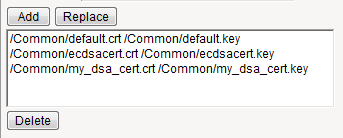Applies To:
Show Versions
BIG-IP AAM
- 13.0.1, 13.0.0
BIG-IP APM
- 13.0.1, 13.0.0
BIG-IP Link Controller
- 13.0.1, 13.0.0
BIG-IP Analytics
- 13.0.1, 13.0.0
BIG-IP LTM
- 13.0.1, 13.0.0
BIG-IP AFM
- 13.0.1, 13.0.0
BIG-IP PEM
- 13.0.1, 13.0.0
BIG-IP DNS
- 13.0.1, 13.0.0
BIG-IP ASM
- 13.0.1, 13.0.0
Overview: Managing client-side HTTP traffic using a CA-signed RSA certificate
When you want to manage HTTP traffic over SSL, you can configure the BIG-IP® system to perform the SSL handshake that target web servers normally perform.
A common way to configure the BIG-IP system is to enable client-side SSL, which makes it possible for the system to decrypt client requests before sending them on to a server, and encrypt server responses before sending them back to the client. In this case, you need to install only one SSL key/certificate pair on the BIG-IP system.
This implementation uses a certificate signed by an RSA certificate authority (CA) to authenticate HTTP traffic.
Task summary
To implement client-side authentication using HTTP and SSL with a certificate signed by a certificate authority, you perform a few basic configuration tasks.
Task list
Requesting an RSA certificate from a certificate authority
Creating a custom HTTP profile
Creating a custom Client SSL profile
Creating a pool to process HTTP traffic
Creating a virtual server for client-side HTTP traffic
Implementation results
After you complete the tasks in this implementation, the BIG-IP® system can authenticate and decrypt HTTP traffic coming from a client system, using an RSA digital certificate. The BIG-IP system can also re-encrypt server responses before sending them back to the client.








